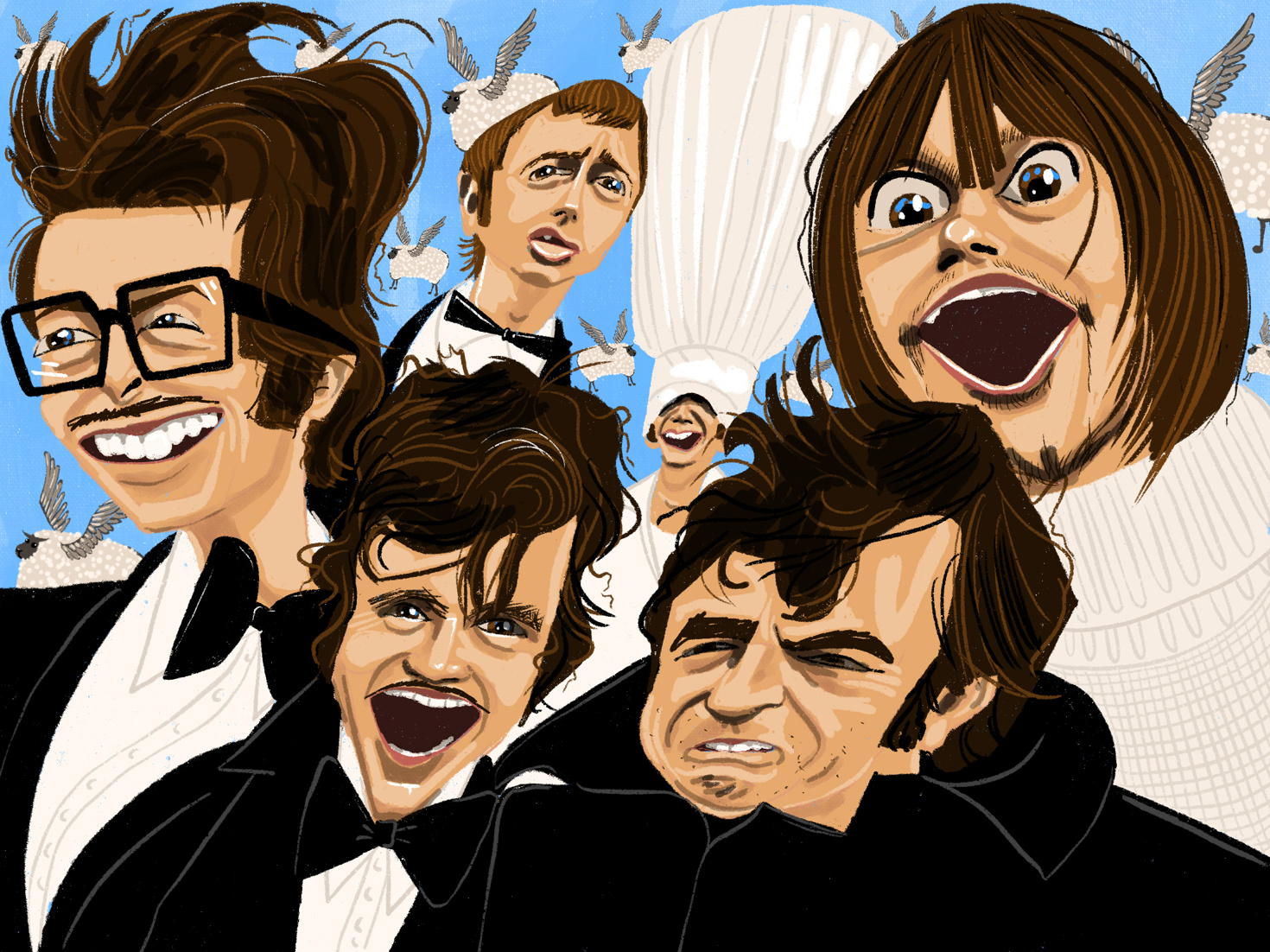
Spamalot: A Completely Serious and Accurate History of How the Show Came to Be, Not Kidding
The Broadway revival of Spamalot is now playing at the St. James Theatre. A “loving ripoff” of the 1975 film Monty Python and the Holy Grail, the show promises two hours and 20 minutes of songs and stupidity. Apparently there are coconuts involved?
OK, for those unfamiliar with the musical, the movie or Monty Python, it all might sound a bit… strange. And so, here’s absolutely everything you need to know about the show and how it came to be. (Apart from anything about the actual legend of King Arthur, you're on your own there.)

THE TV SHOW
In 1969, Monty Python’s Flying Circus premieres on British television. Conceived, written and performed by five Brits and one Minnesotan—Graham Chapman, John Cleese, Eric Idle, Terry Jones, Michael Palin and Terry Gilliam—it’s a sketch comedy show where utter absurdity reigns. Its most famous bits involve flying sheep, a cheese shop without cheese, a politician in charge of silly walks, a restaurant with a highly Spam-oriented menu and an irate pet shop customer with a dead parrot.
In his memoir Always Look on the Bright Side of Life, Idle would describe the Python style of humor as “encyclopedic"—a “compendium of styles.” “[T]here is visual humor, verbal humor, clever humor, silliness, rudeness, sophistication and brazen naughtiness, constantly alternating. Which means there’s something for everyone. I found that while people said they liked it, not everyone could agree on which particular bits they liked.”
Monty Python are, in short, kind of like the Beatles of comedy. Idle would later become close with George Harrison, a huge Python fan, who believed that the Pythons had somehow inherited the joyous and uplifting spirit of the Beatles.
On the television show as well as on their comedy records, the Pythons show a flair for comedic songs, many penned by Idle, who was also the most musical member of the group. Among the most well known are “The Philosophers’ Song,” about the drinking habits of famous philosophers, and “The Lumberjack Song,” about a rugged logging worker who dresses in women’s clothing in his spare time.

John Cleese as Black Knight, Terry Jones as Bedevere, Graham Chapman as King Arthur, Eric Idle as Sir Robin and Chapman, Jones and Michael Palin as the Three-Headed Giant. (Illustration by Ryan Casey)
THE MOVIE
After the final season of Monty Python’s Flying Circus airs in 1972, the Pythons begin work on their first proper feature film: a comedic retelling of the myth of King Arthur and his knights’ quest for the Holy Grail. The Pythons conduct intensive research for the project; Jones, who co-directs the film with Gilliam, later becomes a respected medieval historian. A who’s who of ‘70s British rock royalty help fund the film, including Led Zeppelin, Pink Floyd, Jethro Tull and Elton John.
The shoot itself is fairly miserable. Years later, when asked if there were any takeaways from the experience, Idle would remark, “Try and stay out of soggy woolen armor.”
The resulting film, Monty Python and the Holy Grail, features several moments that become signatures of the Python sense of humor, including a taunting Frenchman, a sickly man who’s “not dead yet,” an argumentative peasant and an encounter with the fearsomely stubborn Black Knight. No gag would become more iconic, however, than the spectacle of knights, in full medieval regalia, mimicking the sound of horses’ hooves by banging coconut halves together. “It’s a ridiculous thing to do,” Palin later said of the bit. “[But] you absolutely believed that they believed that they were on horses. That was much funnier than giggling about it.”
The movie features just a couple of songs, including “Brave Sir Robin” by honorary Python member Neil Innes (a sample of Innes' genteel lyrics: “He was not in the least bit scared to be mashed into a pulp; Or to have his eyes gouged out and his elbows broken”) and “Knights of the Round Table,” whose comedy lies partly in its effortful rhymes: “We dine well here in Camelot; We eat ham and jam and spam a lot.”
The movie is a hit and gains a cult following. Among its fans is Elvis Presley, who endlessly quotes the Black Knight to anyone who'll listen.

THE MUSICAL
Fast forward a few decades. After Monty Python’s Life of Brian (1979) and Monty Python and The Meaning of Life (1983), the Python troupe hasn’t worked together in a meaningful sense for years.
In the ’90s, Idle works on a Monty Python and the Holy Grail video game. If the movie had worked in that format, he thought, why not a stage musical? Idle was no stranger to Broadway, having worked on Seussical: The Musical early in its development.
With the blessing of his fellow Pythons, Idle starts the process of adapting the movie into a musical, working with his frequent musical collaborator John Du Prez. In Idle’s conception, the show retains many of the beloved moments from the movie while finding new opportunities for hilarity, including plenty of bits taking the pee out of Broadway (to use the British idiom favored by Idle).
To direct, Idle approaches Mike Nichols, a close friend since the ’70s. (Nichols had also wanted to cast Cleese in The Remains of the Day; the role went to Anthony Hopkins.) Nichols’ response, Idle would write in his memoirs, was “Yes, yes, yes.” For his own part, Nichols says his initial response was, “Go away.”
David Hyde Pierce practically begs to be involved in the project; he is cast as Sir Robin. Hank Azaria tells the team he’s been preparing for the role since he was 12; he is cast as Sir Lancelot. “Talk about a dream come true, or a wish fulfillment that I didn’t even know I had,” Azaria would say later. “I mean, I also would love to play shortstop for the New York Mets, and put an ‘S’ on my chest and fly over the city. Those two things are not going to happen. I swear to you, being able to jump in on some kind of Python production and be a Python was on that level for me.”
Tim Curry, Idle’s choice, reads for King Arthur at a gathering at Idle’s home, and gets the part.
At Nichols’ suggestion, "Always Look on the Bright Side of Life," the sing-along musical number from Monty Python’s Life of Brian, written by Idle, is lovingly shoehorned into the show. Nichols also brings in Casey Nicholaw (now a two-time Tony winner) to choreograph—his first Broadway choreographing credit. Painstakingly refining the comedy in the rehearsal room, Nichols constantly reminds the actors: “You must make them real.”
Spamalot, which also stars Sara Ramirez as the Lady of the Lake, opens on February 14, 2005 at the Shubert Theatre. The opening-night celebration features a huge castle built out of Spam cans; Roger Waters, David Bowie and Lou Reed are in attendance.
The show goes on to receive 14 Tony Award nominations, winning in three categories: Best Musical, Best Direction of a Musical and Best Performance by a Featured Actress in a Musical for Ramirez. It closes after 1,575 performances on Broadway but… Well, it’s not dead yet.
